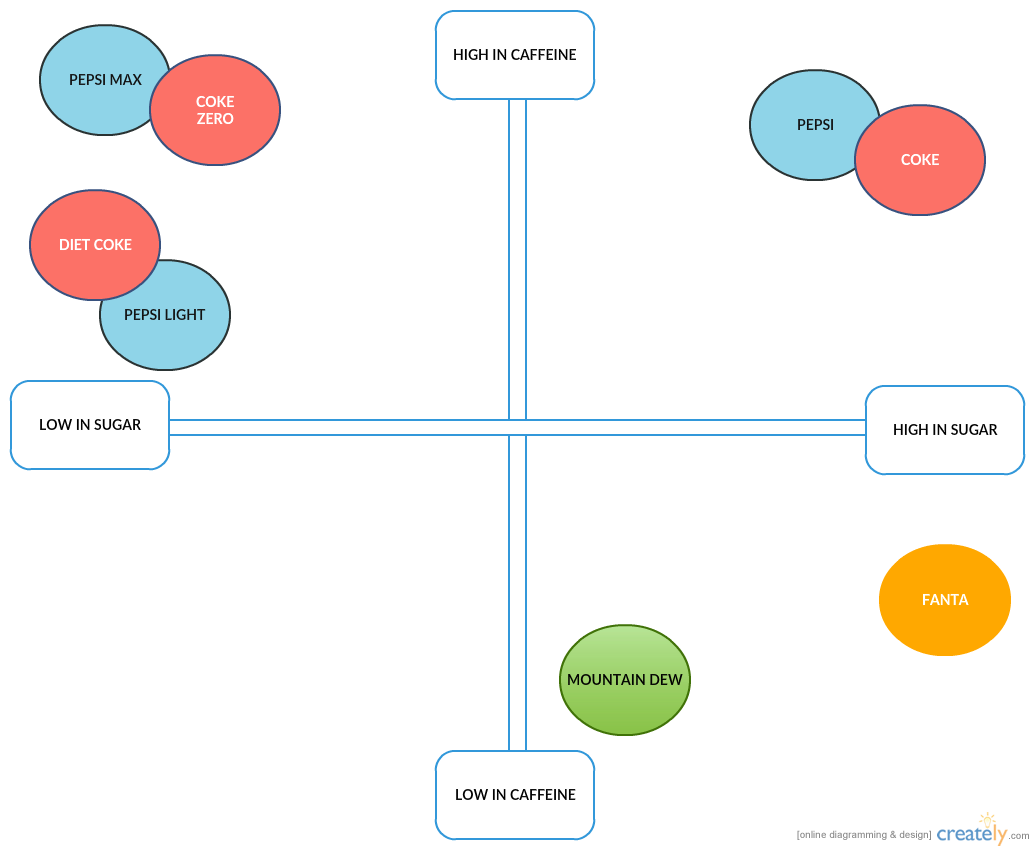Positioning Map
The positioning or perceptual mapping is a tool that is being used by marketers to graphically illustrate a product’s unique features, thereby differentiating it from similar options provided by competitors within an industry (Boone & Kurtz, 2013). The strategic management tool allows manufacturers to better understand complex relationships between different sets of attributes offered by their marketplace competitors as well as how they are being used by buyers during the process of making purchase decisions (Boone & Kurtz, 2013).

The mapping technique used for building the positioning map allows illustrating comparative differences in how soft drinks of some of the most popular soda brands are rated on two sets of attributes (Boone & Kurtz, 2013). Taking into consideration the fact that price becomes a deciding factor in influencing consumers’ purchasing intentions only after other important criteria have been met, the map does not represent this attribute (Boone & Kurtz, 2013). Instead, the axis points of the positioning map reflect the amount of sugar and caffeine as determinant attributes that affect purchasing decisions, thereby providing products with distinct market positioning.
The map compares the possible perceptions of the two attributes of the following products: Pepsi, Coke, Mountain Dew, Fanta, Pepsi Max, Pepsi Light, Coke Zero, and Diet Coke. After the combination of the two attributes has been determined, all products have been assigned average scores on each dimension and placed in the representational space of the positioning map. The analysis of attribute ratings shows that Coke and Pepsi are the two products that are placed closely together on the perceptual map. It means that consumers perceive their offerings as similar ones across the whole range of products. Another conclusion that can be derived from the map analysis is that there are significant variations in the amount of sugar in the soft drinks produced by Pepsi and Coca-Cola companies. The same holds about diet offerings of the companies: Pepsi Max, Pepsi Light, Coke Zero, and Diet Coke.
Therefore, it is clear that the market perceives a substantial level of variation across the whole range of Pepsi and Coca-Cola soft drinks presented on the map. It leads to a logical conclusion that taking into consideration a large size of the market share held by the two firms, other products such as Fanta and Mountain Dew will find it difficult to overcome competitive barriers put in place by Pepsi and Coca-Cola. The shared product positioning also means that there is a high level of competition between the two soft drinks producers. A low level of positioning differential between the low-sugar products of Pepsi and Coca-Cola placed in the top left quadrant of the positioning map suggests that the firms are open to market cannibalization between their product lines, which can drastically affect their sales.
The analysis of attribute ratings suggests that both Mountain Dew and Fanta are extremely well-positioned and hold a distinctive space in consumer preferences represented on the map. Therefore, it can be argued that managers of Pepsi and Coca-Cola companies should consider exploring an opportunity by creating products in a similar market range. The positioning map reveals a gap in its bottom left quadrant. It means that there is a market opportunity that can be explored by Coke, Pepsi, Fanta, and Mountain Dew producers.
Situation Analysis
Situation analysis allows marketing managers to assess the environment in which the implementation of a marketing plan will occur. The following analysis will help to explore and assess the most important dimensions of the macro-level external environment in which Seconal Foods operates. Seconal Foods is a company that specializes in the retail of organic foods with an extremely limited amount of artificial preservatives, sweeteners, colors, and flavors.
SWOT analysis is an essential part of a marketing plan (Boone & Kurtz, 2013). By including a situation analysis into a SWOT analysis, it is possible to organize the results of the former in an efficient and visually stimulating manner (Chapter 2). Table 1 shows a combination of a SWOT analysis and a situation analysis of Seconal Foods.
Table 1. SWOT and Situation Analyses of Seconal Foods.
The situation analysis has allowed creating four ideas for the marketing strategy that might be useful for “each of the four situational scenario combinations represented” (Chapter 2, p. 43) in the table above. Open facilities in Canada is a strategy that utilizes internal strengths such as a wide product range and a high quality of products to explore the external opportunity of expanding overseas. To take advantage of the opportunity, it is necessary to conduct a marketing campaign that will target health-conscious consumers in the country. Exploring a large network of suppliers for rapid expansion overseas will help Seconal Foods to avoid competition from companies like Whole Foods that are highly dependent on their limited supplier base.
The provision of value-added services such as diet plans and free nutrition consultations is a strategy that overcomes internal weakness associated with a lack of brand recognition and capitalizes on an opportunity. Moreover, by providing Seconal Foods’ customers with value-added services, it will be much easier to expand to other market segments. The last marketing strategy that might be used in a situational scenario when it is necessary to reduce internal weaknesses and escape external threats is the expansion of the foreign market. International expansion will help Seconal Foods substantially reduce its overdependence on the U.S. market which is associated with the threat of economic downfall. The strategy will allow the company to increase its presence overseas by eliminating its vulnerability to swings in the local economy.
References
Boone, L., & Kurtz, D. (2013). Contemporary marketing, 2015 update, New York, NY: Cengage Learning.